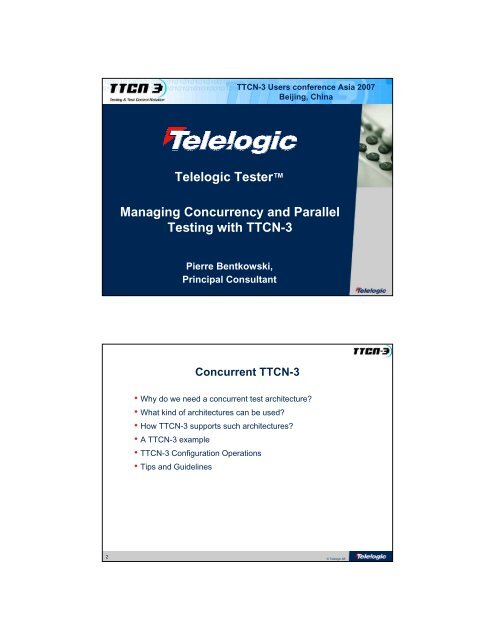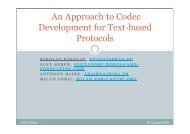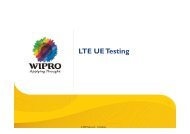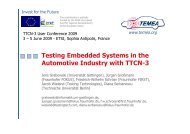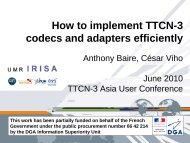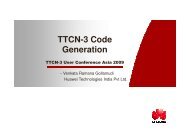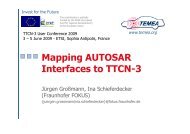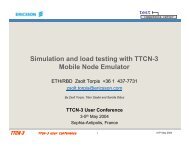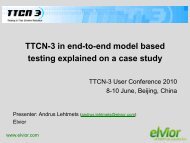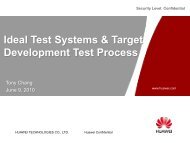Managing Concurrency and Parallel Testing with TTCN-3 Telelogic ...
Managing Concurrency and Parallel Testing with TTCN-3 Telelogic ...
Managing Concurrency and Parallel Testing with TTCN-3 Telelogic ...
Create successful ePaper yourself
Turn your PDF publications into a flip-book with our unique Google optimized e-Paper software.
<strong>TTCN</strong>-3 Users conference Asia 2007Beijing, China<strong>Telelogic</strong> Tester<strong>Managing</strong> <strong>Concurrency</strong> <strong>and</strong> <strong>Parallel</strong><strong>Testing</strong> <strong>with</strong> <strong>TTCN</strong>-3Pierre Bentkowski,Principal Consultant1© <strong>Telelogic</strong> ABConcurrent <strong>TTCN</strong>-3• Why do we need a concurrent test architecture?• What kind of architectures can be used?• How <strong>TTCN</strong>-3 supports such architectures?• A <strong>TTCN</strong>-3 example• <strong>TTCN</strong>-3 Configuration Operations• Tips <strong>and</strong> Guidelines2© <strong>Telelogic</strong> AB
Terminology• PCO• CP• MTC• PTC• TS• TSI• SUTPoint of Control <strong>and</strong> Observation (Port type)Control Point (Port type)Main Test Component (Component type)<strong>Parallel</strong> Test Component (Component type)Test SystemTest System InterfaceSystem Under TestTester1Tester2SystemUnderTest3© <strong>Telelogic</strong> ABTerminology• PCO• CP• MTC• PTC• TS• TSI• SUTTSPoint of Control <strong>and</strong> Observation (Port type)Control Point (Port type)Main Test Component (Component Type)<strong>Parallel</strong> Test Component (Component Type)Test SystemTest System InterfaceSystem Under TestPCOCPPTCTSISUTMTCCPPTCPCO4© <strong>Telelogic</strong> AB
Why do we need a concurrent testarchitecture?• By nature, devices <strong>and</strong> users which are interfaced to the SUTare functioning in a concurrent manner.• Even <strong>with</strong> perfectly synchronized inputs to the SUT, there areno guaranties that the SUT will reply <strong>with</strong> the exact samesequence of outputs.Tester1SUTTester25© <strong>Telelogic</strong> ABWhy do we need a concurrent testarchitecture?• Tester T1 sends the message A to the SUT• The SUT replies to both Testers, T1 <strong>and</strong> T2• The SUT first sends B to T1, then C to T2• Therefore the Test Sequence is {T1!A,T1?B,T2?C}T1SUTT2ABC6© <strong>Telelogic</strong> AB
Why do we need a concurrent testarchitecture?• Tester T1 sends the message A to the SUT• The SUT replies to both Testers, T1 <strong>and</strong> T2• The SUT first sends C to T2, then B to T1• Therefore the Test Sequence is {T1!A,T2?C,T1?B}T1SUTT2ABC7© <strong>Telelogic</strong> ABWhy do we need a concurrent testarchitecture?• Tester T1 sends the message A to the SUT• The SUT replies to both Testers, T1 <strong>and</strong> T2• The SUT first sends B to T1, then C to T2• The communication channel adds a delay on B• Therefore the Test Sequence is {T1!A,T2?C,T1?B}T1SUTT2ABC8© <strong>Telelogic</strong> AB
Why do we need a concurrent testarchitecture?• The non-deterministic behaviors of the SUT <strong>and</strong> the channeldelays yield to a set of possible sequences.– This trivial example yields to 2 possible outcomes.• Having this kind of alternatives would soon generate verycomplex non-concurrent test case descriptions.testcase TC_NonConcurrent_01()runs on HostType {T1.send(A);alt {[] T1.receive(B){T2.receive(C)}[] T2.receive(C){T1.receive(B)}}// other events ...}9© <strong>Telelogic</strong> ABWhy do we need a concurrent testarchitecture?• Conformance testing:– A PBX must accept 12 simultaneous connection requests.– A railroad switching controller must compute inputs from 4detection devices <strong>and</strong> give feedback.• Service, function <strong>and</strong> feature testing:– Establish a 3-way conference.• Stress, robustness <strong>and</strong> load testing:– System must accept 13 simultaneous Service Requestsmultiple times during a sustaining period of time.10© <strong>Telelogic</strong> AB
What kind of architecture can be used?• Architecture <strong>with</strong> multiple testers of the same type <strong>with</strong> onlyone interface.Tester1Tester2SystemUnderTestTester311© <strong>Telelogic</strong> ABWhat kind of architecture can be used?• All testers used the same set of messages <strong>and</strong> interfaces: oneport definition.• All testers are identical: one component type.Tester1MasterTester2SystemUnderTestTestSystemTester312© <strong>Telelogic</strong> AB
What kind of architecture can be used?• Architecture <strong>with</strong> multiple testers of different type.• Each tester uses its own unique interface.Tester1Tester2SystemUnderTestTester313© <strong>Telelogic</strong> ABWhat kind of architecture can be used?• Each tester uses different set of messages <strong>and</strong> interfaces:multiple port types.• Each tester is different: multiple component types.• But one port type per component type.Tester1MasterTester2SystemUnderTestTestSystemTester314© <strong>Telelogic</strong> AB
What kind of architecture can be used?• Architecture <strong>with</strong> multiple testers of different types.• Each tester type can have multiple kind of interfaces.Tester1Tester2Tester3VideoVoiceUSB/IPFireWire/IPSystemUnderTest15© <strong>Telelogic</strong> ABWhat kind of architecture can be used?• Each tester uses different set of messages <strong>and</strong> interfaces:multiple port definitions.• Each tester is different: multiple component types.• Multiple port types per component type.MasterTester1Tester2VideoVoiceUSB/IPSystemUnderTestTestSystemTester3FireWire/IP16© <strong>Telelogic</strong> AB
What kind of architecture can be used?• The Executable Test Suite can be:– One Node - Multi-threaded (Simplest, Default)–Multi-Node–MixedMasterTester1Tester3SUTTester2TestSystem17© <strong>Telelogic</strong> ABHow <strong>TTCN</strong>-3 support such architectures?• Dynamic creation of the test configuration– Creation of components• create– Creation of connections between Components•map, unmap– Creation of connections <strong>with</strong> the TSI/SUT• connect, disconnect• Dynamic control of the component behavior– Control of component behavior•start, stop, kill– Lookup of component behavior• running, done, alive, killed18© <strong>Telelogic</strong> AB
How <strong>TTCN</strong>-3 support such architectures?• Communication between components– Exchange of messages between components•send, receive– Implicit verdict mechanism•setverdict, getverdict• none, pass, inconc, fail, error19© <strong>Telelogic</strong> ABA <strong>TTCN</strong>-3 Example// Behavior descriptiontestcase TC_Concurrent_01()runs on MTC_Typesystem TSI_Type {...}mtc:MTC_Typesystem:TSI_Type20© <strong>Telelogic</strong> AB
A <strong>TTCN</strong>-3 Example// Behavior description...PTC1 := PTC1Type.createPTC2 := PTC2Type.create...CP1mtcCP2type component PTC1Type {port CP_Type CP;port PCO1bType PCO1b;}type component PTC2Type {port CP_Type CP;port PCO2bType PCO2b;}// other components ...type port PCO1bType message {inout // messages ..}// other ports ...CP:CP_Type CP:CP_TypePTC1PTC2PCO1b:PCO1bType PCO2b:PCO2bTypePCO1aPCO2asystem23© <strong>Telelogic</strong> ABA <strong>TTCN</strong>-3 Example// Behavior description...connect(mtc:CP1, PTC1:CP);connect(mtc:CP2, PTC2:CP);...CP1mtcCP2CPCPPTC1PTC2PCO1bPCO1asystemPCO2bPCO2a24© <strong>Telelogic</strong> AB
A <strong>TTCN</strong>-3 Example// Behavior description...map(PTC1:PCO1b, system:PCO1a);map(PTC2:PCO2b, system:PCO2a);...CP1mtcCP2CPCPPTC1PTC2PCO1bPCO1asystemPCO2bPCO2a25© <strong>Telelogic</strong> ABA <strong>TTCN</strong>-3 Example// Behavior description...PTC1.start(TS_InitiateCall());PTC2.start(TS_AnswerCall());...mtcfunction TS_InitiateCall()runs on PTC1Type {...PCO1b.send(msg1);...}PTC1PTC2function TS_AnswerCall()runs on PTC2Type {...PCO2b.receive(msg2);CP.send(statusConnected);...}msg1system26© <strong>Telelogic</strong> AB
A <strong>TTCN</strong>-3 Example// Behavior description...PTC1.start(TS_InitiateCall());PTC2.start(TS_AnswerCall());...mtcfunction TS_InitiateCall()runs on PTC1Type {...PCO1b.send(msg1);...}PTC1PTC2function TS_AnswerCall()runs on PTC2Type {...PCO2b.receive(msg2);CP.send(statusConnected);...}systemmsg227© <strong>Telelogic</strong> ABA <strong>TTCN</strong>-3 Example// Behavior description...PTC1.start(TS_InitiateCall());PTC2.start(TS_AnswerCall());...function TS_InitiateCall()runs on PTC1Type {...PCO1b.send(msg1);...}PTC1mtcstatusConnectedPTC2function TS_AnswerCall()runs on PTC2Type {...PCO2b.receive(msg2);CP.send(statusConnected);...}system28© <strong>Telelogic</strong> AB
Creating normal component• Components are automatically destroyed at the end of theexecuted behavior function or when stoppedvar PTCType ptcname;ptcname := PTCType.create("InstanceName");... // connect, map, ...ptcname.stop;ptcname := PTCType.create("InstanceName");... // connect, map, ...ptcname.done;ptcname := PTCType.create("InstanceName");... // connect, map, ...29© <strong>Telelogic</strong> ABCreating alive-type component• Alive Components can execute multiple behavior functions• Components are not destroyed when stopped or when therebehavior is donevar PTCType ptcname;ptcname := PTCType.create("InstanceName") alive;... // connect, map, ...ptcname.start(TS_BehaviorTwo());ptcname.done;ptcname.start(TS_BehaviorThree());ptcname.done;ptcname.kill;ptcname := PTCType.create("InstanceName") alive;... // connect, map, ...30© <strong>Telelogic</strong> AB
Connecting <strong>and</strong> mapping• After creation of the components we need to connect portsbetween MTC/PTC components <strong>and</strong> map ports between anMTC/PTC component <strong>and</strong> the Test System Interface – TSI– The mtc-keyword identifies the MTC, system identifies the TSIinstance <strong>and</strong> the self-keyword identifies the currently executingMTC/PTC• Without connecting/mapping a component cannotcommunicate <strong>with</strong> the outside world• When connecting port A <strong>and</strong> port B, the in list of port A mustmatch the out list of port B <strong>and</strong> vice versa• When mapping port A <strong>and</strong> port B, the in list of port A mustmatch the in list of port B, <strong>and</strong> the out list of port A must matchthe out list of port B31© <strong>Telelogic</strong> ABUnconnect <strong>and</strong> Unmap• Connections <strong>and</strong> Mappings can be undone, to changeconfiguration during the runtime of the test• Syntax is the same as for connect <strong>and</strong> map32© <strong>Telelogic</strong> AB
Starting <strong>and</strong> Stopping test components• Once components are created <strong>and</strong> connected/mapped, theycan be started• The behavior to be executed by the component is given in thestart comm<strong>and</strong>– The behavior is defined as a function• Components can be stopped using the stop comm<strong>and</strong>– Only the execution of test behavior is stopped.– Components can stop themselves, or other components• Components can be destroyed using the kill comm<strong>and</strong>– The execution of test behavior is stopped - if any– All associated resources (including all port connections) are freed– Components can kill themselves, or other components33© <strong>Telelogic</strong> ABQuerying test components• The running operation returns a boolean value based onwhether the component is running or not• The alive operation returns a boolean value based on weatherthe component is already executing or ready to executebehavior, or not• The done operation can only be executed when thecomponent has completed its behavior• The killed operation can only be executed when thecomponent has been destroyed34© <strong>Telelogic</strong> AB
Details from ETSI ES 201 873-1 v3.2.135© <strong>Telelogic</strong> ABDetails from ETSI ES 201 873-1 v3.2.136© <strong>Telelogic</strong> AB
Tips <strong>and</strong> Guidelines• Common behavior must be defined in functionfunction TS_SetupConnection()runs on PTC1Type {...PCO1.send(msg1);...• Theses functions can be called by any other function runningon the same component type.• These function should be parameterized <strong>with</strong> the PCO <strong>and</strong> CPthat they use.function TS_SetupConnection(pco:PCOType)runs on PTC1Type {...pco.send(msg1);...37© <strong>Telelogic</strong> ABTips <strong>and</strong> Guidelines• It is strongly recommended to check that the PTCs havefinished their execution, <strong>with</strong> the use of the DONE statement inMTC, before terminating the MTC.all component.done;setverdict(pass);stop;38© <strong>Telelogic</strong> AB
Tips <strong>and</strong> Guidelines• There is no need to explicitly passed PTC verdicts to the MTCusing coordination messages– A global verdict is automatically maintained by the MTC– The global verdict is updated whenever a component terminates– Remember: Verdict never improve– Make the <strong>TTCN</strong>-3 script more readable39© <strong>Telelogic</strong> AB<strong>Testing</strong> Concept: Self-test of Test Cases• Use <strong>Concurrency</strong> to perform aself-test of a test case– All behavior is encapsulated in afunction. In the normal case, thisfunction is simply called in theMTC– For Self-<strong>Testing</strong>, a Simulation ofeach of the SUT Ports isimplemented in one or more<strong>Parallel</strong> Test Components (PTCs).They are connected to the MTCports– Since the Test System Interfacecan be left empty, SUT Adaptationis not needed for the self-test testsuiteNormalTest systemTest System InterfaceSUTSelftestTest systemPTC (Simu1)PTC (Simu2)Behavior_function()Test System InterfaceMTCBehavior_function()MTC40© <strong>Telelogic</strong> AB
Benefits <strong>with</strong> Concurrent <strong>TTCN</strong>• Less code to write• Can have several test architectures in the same test suite• Several service providers can be used• Other components can be created at any time during the testcase execution• <strong>Concurrency</strong>– We can have several components executing simultaneously– Several processes aiming at the same goal41© <strong>Telelogic</strong> AB


